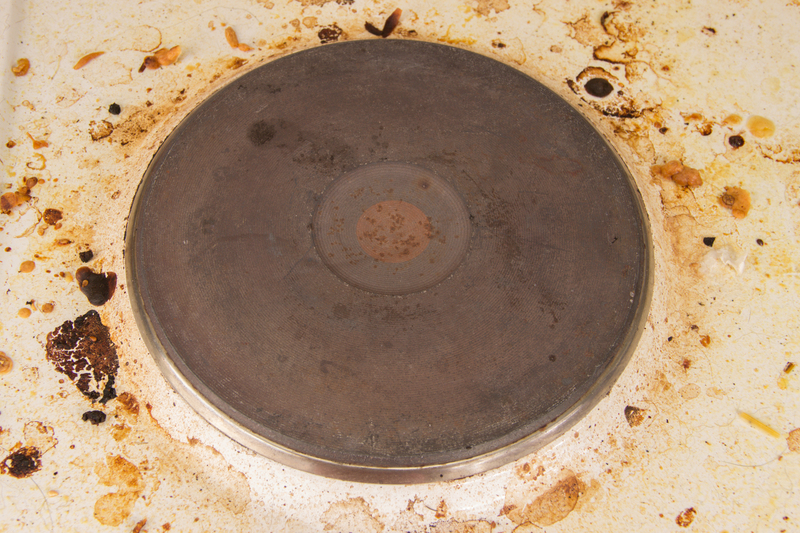Expert Advice: How to Deal with Stubborn Stovetop Residue
Posted on 24/09/2025
Expert Advice: How to Deal with Stubborn Stovetop Residue
Cooking can be a joyful experience, but the aftermath often presents a big challenge: stubborn stovetop residue. Whether you have a glass cooktop splattered with sauces or a gas stove crusted over with burned-on food, cleaning your stovetop can be both tedious and time-consuming. Expert advice on dealing with stubborn stovetop residue can save you hours of frustration and help maintain the longevity and appearance of your cooking surface.
Understanding Stovetop Residue: Why Does It Build Up?
Before diving into cleaning methods, it's vital to grasp why stovetop residue becomes so stubborn in the first place. Cooking oils, sugary spills, and food particles that aren't cleaned right away are constantly exposed to high heat. This causes them to become baked-on and hard to remove, especially when left unattended. Frequent use exacerbates the problem, particularly with sticky substances and greasy splatters common during everyday meal prep.
- Grease Splatter: Oil droplets quickly bond with dust and burnt particles, forming a sticky residue.
- Sugar Spills: Caramelization of sugar creates a hard, glass-like layer that's tricky to lift.
- Burnt Food: Small overflow incidents, like pasta water or sauces, quickly bake onto the surface.
- Neglected Cleaning: Allowing some time to pass after cooking makes grime harder to remove.

Initial Preparations: Setting the Stage for Effective Cleaning
Safety first: Before starting the cleaning process, always ensure your stove is completely turned off and has cooled down. If you're cleaning an electric or induction stovetop, unplug where possible to avoid accidental activation.
Gather the Recommended Cleaning Supplies
- Baking soda -- a gentle abrasive
- White vinegar -- for its degreasing and deodorizing properties
- Non-scratch sponges or microfiber cloths
- Dedicated stove cleaner (commercial option for tough stains)
- Plastic scraper or old credit card (for glass stovetops)
- Old toothbrush (for crevices)
- Soft towels for drying and buffing
- Gloves to protect your hands
Step-by-Step Cleaning Guide: Removing Persistent Stovetop Grime
If you're struggling with stubborn stovetop residue that regular wiping won't budge, follow these step-by-step instructions for a truly deep clean.
1. Start with Loose Debris
- Using a dry microfiber towel or paper towel, wipe away loose crumbs and food particulates.
- This prevents scratching the surface when you apply cleaning solutions.
2. Apply a Degreasing Solution
- Mix a solution of equal parts vinegar and water in a spray bottle.
- Generously spray the entire stovetop, focusing on areas with visible grease or marks.
- Let it sit for at least 5-10 minutes to break down the stubborn residue.
3. Use Baking Soda for Gentle Abrasion
- Sprinkle baking soda liberally over the toughest spots. The alkaline property of baking soda softens caked-on food.
- Dampen a clean sponge (non-scratch recommended) and gently scrub in a circular motion.
- For glass cooktops, utilize a plastic scraper at a shallow angle for particularly resistant stains.
4. Tackle Baked-On Spots with a Paste
- For extremely persistent residue, mix a thick paste of baking soda and water.
- Apply directly to the residue and cover with a damp cloth. Allow it to sit for up to 30 minutes.
- Scrub with the sponge or a soft brush; for gas stoves, use the old toothbrush to address crevices and around burner caps.
5. Wipe and Polish
- After scrubbing, wipe off residue with a damp microfiber cloth.
- Follow up with a dry towel to prevent streaks and water spots. For a shiny cooktop, buff gently with a soft, dry cloth.
Specialized Cleaning Techniques by Stovetop Type
Not all stove surfaces are the same. Each requires specialized care to avoid damage and lift stubborn stove residue efficiently.
Gas Stovetops
- Remove Grates and Burner Caps: Soak in hot, soapy water for at least 15 minutes. Use a stiff brush for caked-on grime.
- Use a baking soda paste on stubborn spots, then scrub gently and rinse thoroughly.
- For hard-to-reach spots, use a toothbrush or cotton swabs.
Electric Coil Stoves
- Remove coils once completely cooled and clean separately.
- Wipe down drip pans using degreaser and a sponge. For baked-on messes, soak drip pans in vinegar and baking soda.
- NEVER immerse coils in water. Instead, wipe with a damp cloth and dry thoroughly.
Glass or Ceramic Cooktops
- Use special glass cooktop cleaners to avoid scratches.
- Stubborn, burnt residue can often be lifted with a razor blade scraper at a 45-degree angle--gently wiggle underneath residue without digging into the glass.
- Follow up with a vinegar-and-water spray to eliminate streaks.
Eco-Friendly and Homemade Solutions
Many commercial stovetop cleaners are effective, but a variety of eco-friendly and budget-conscious solutions work equally well. Consider these natural alternatives:
- Baking Soda & Vinegar: The classic reaction helps lift stubborn grit.
- Lemon Juice: The citric acid in lemon cuts through grease and leaves a pleasant scent.
- Hydrogen Peroxide: Combine with baking soda to create an active fizz for burnt-on messes.
- Castile Soap: A few drops with hot water on a sponge cleans residue without harsh chemicals.
Top Expert Tips to Prevent Stubborn Stovetop Residue
Even the most thorough cleaning regime is easier with consistent preventive care. Here are some expert-endorsed tips to keep your stovetop shining between deep cleans:
- Wipe Spills Immediately: Quick action prevents food from baking onto the surface.
- Use Splatter Guards: Cover pans to minimize oil and sauce splashes.
- Clean Burner Grates Weekly: Regular maintenance avoids calcium buildup and stuck food.
- Avoid Harsh Scrubbing Pads: Steel wool and abrasives can scratch or dull your stovetop finish.
- Use lined drip pans to catch overflows and make them easier to clean.
- Schedule a Deep Clean: At least once a month, depending on cooking frequency.
- Never use chemical oven cleaners on stovetops unless specifically formulated for your surface.
Common Mistakes to Avoid When Cleaning Stovetops
Understanding what not to do can be just as important as learning effective techniques. Here are frequent errors that can make stovetop residue even harder to remove or damage your appliance:
- Using Abrasive Pads: Scouring pads and steel wool cause permanent scratches on glass and enamel.
- Applying Excessive Water: This can seep into electric components and cause short circuits.
- Overusing Harsh Chemicals: These can discolor or corrode certain surfaces.
- Skipping Manufacturer Instructions: Always check your stovetop manual for cleaning guidelines.
Frequently Asked Questions About Stubborn Stovetop Residue
Why won't my stovetop come clean even after scrubbing?
Stubborn residue can resist basic cleaning due to repeated heating and layering of grime. Multiple cleaning attempts with a mix of baking soda paste and an appropriate tool (like a plastic scraper) are often necessary.
Can I use bleach to clean my stovetop?
Bleach is not recommended for most stovetop surfaces as it may discolor or degrade glass and enamel finishes. Stick to gentle cleaners or specialized stovetop products.
How often should I deep-clean my stovetop?
For heavy use, weekly or bi-weekly deep cleaning prevents residue buildup. For occasional cooks, monthly cleaning is sufficient if spills are handled immediately.

Recommended Products for Stovetop Cleaning
Many products are available to help you deal with stubborn stovetop residue:
- Bar Keepers Friend Cooktop Cleaner: Trusted for glass and ceramic surfaces.
- Weiman Gas Range Cleaner & Degreaser: Strong on baked-on grease, safe for most surfaces.
- Magic Eraser pads (for light residue, not for heavy scrubbing on glass).
- Microfiber cloths: Non-abrasive, perfect for buffing and daily cleaning.
Conclusion: Achieve a Sparkling Stovetop with Expert Advice
A spotless, streak-free stove is more than just aesthetically pleasing--it's safer and enhances the performance of your appliance. By following this expert advice on dealing with stubborn stovetop residue, you'll ensure hassle-free cooking and a longer-lasting, beautiful kitchen centerpiece.
Remember: Act fast on spills, clean regularly, use gentle yet effective techniques, and match your methods to the type of cooktop you own. With the right approach, even the most stubborn stovetop residue doesn't stand a chance!
Put these cleaning insights to the test and enjoy the rewards of a gleaming kitchen every day!




